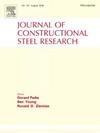Seismic acceleration response prediction method of the PSCFST bridge based on TCN
IF 4
2区 工程技术
Q1 CONSTRUCTION & BUILDING TECHNOLOGY
引用次数: 0
Abstract
Precast segment self-centering concrete filled steel tube (PSCFST) bridge has become a research hotspot in the field of infrastructure because of its excellent seismic performance and self-centering resilience. However, the highly nonlinear response of bridge structures due to their size and complexity poses a serious challenge to the accurate prediction of their seismic response, especially under extreme conditions such as earthquakes. This study presents a prediction method utilizing a temporal convolutional neural network prediction method to accurately forecasting the acceleration response of PSCFST bridge under seismic actions. The dataset was constructed by integrating data obtained from PSCFST single-span bridge shaking table tests and finite element model simulations. The Temporal Convolutional Network (TCN) model is employed as the training architecture, using acceleration time histories from diverse ground motions as inputs and the acceleration response of the bridge's superstructure as the training output. The TCN model employs causal expansion convolution to effectively capture long-term dependence in the time series data of the bridge structure's acceleration response. Furthermore, superposition of residual blocks enables the extraction of more profound nonlinear features at each data layer, thereby facilitating precise forecasting of acceleration responses in the bridge superstructure. The TCN model ensures capturing longer-span temporal correlations while reducing the model parameters, thereby achieving accurate and efficient prediction of bridge seismic response. Detailed comparative experiments were conducted among various algorithmic models, including Recurrent Neural Network (RNN), Long Short-Term Memory (LSTM), Support Vector Regression (SVR), Extreme Gradient Boosting (XGBoost), and Random Forest Regression (RFR). The results validate that the TCN model demonstrates higher prediction accuracy, better generalization capability, faster training speed, and fewer model parameters. These findings comprehensively demonstrate the superiority of the TCN model in predicting bridge vibration responses, offering an effective prediction methodology for enhancing the safety and reliability of bridge structures under seismic actions.
基于 TCN 的 PSCFST 桥梁地震加速度响应预测方法
预制节段自定心混凝土填充钢管(PSCFST)桥梁因其优异的抗震性能和自定心抗震能力而成为基础设施领域的研究热点。然而,由于桥梁结构的尺寸和复杂性,其高度非线性响应对其地震响应的准确预测提出了严峻挑战,尤其是在地震等极端条件下。本研究提出了一种预测方法,利用时序卷积神经网络预测方法准确预测 PSCFST 桥梁在地震作用下的加速度响应。数据集是通过整合 PSCFST 单跨桥梁振动台试验和有限元模型模拟获得的数据而构建的。采用时序卷积网络(TCN)模型作为训练架构,将不同地面运动的加速度时间历程作为输入,将桥梁上部结构的加速度响应作为训练输出。TCN 模型采用因果扩展卷积,可有效捕捉桥梁结构加速度响应时间序列数据中的长期依赖性。此外,残差块的叠加可以提取各数据层更深刻的非线性特征,从而促进对桥梁上部结构加速度响应的精确预测。TCN 模型在减少模型参数的同时,还能确保捕捉到更长跨度的时间相关性,从而实现对桥梁地震响应的精确、高效预测。对各种算法模型进行了详细的对比实验,包括循环神经网络(RNN)、长短期记忆(LSTM)、支持向量回归(SVR)、极梯度提升(XGBoost)和随机森林回归(RFR)。结果验证了 TCN 模型具有更高的预测精度、更好的泛化能力、更快的训练速度和更少的模型参数。这些结果全面证明了 TCN 模型在预测桥梁振动响应方面的优越性,为提高地震作用下桥梁结构的安全性和可靠性提供了有效的预测方法。
本文章由计算机程序翻译,如有差异,请以英文原文为准。
求助全文
约1分钟内获得全文
求助全文
来源期刊

Journal of Constructional Steel Research
工程技术-工程:土木
CiteScore
7.90
自引率
19.50%
发文量
550
审稿时长
46 days
期刊介绍:
The Journal of Constructional Steel Research provides an international forum for the presentation and discussion of the latest developments in structural steel research and their applications. It is aimed not only at researchers but also at those likely to be most affected by research results, i.e. designers and fabricators. Original papers of a high standard dealing with all aspects of steel research including theoretical and experimental research on elements, assemblages, connection and material properties are considered for publication.
 求助内容:
求助内容: 应助结果提醒方式:
应助结果提醒方式:


